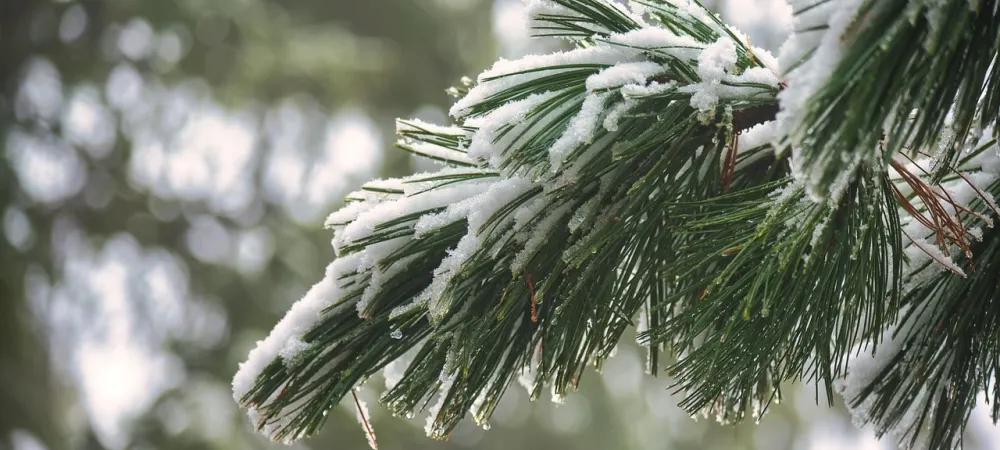
How to Protect Your Evergreens Through Winter
Every year, southern homeowners treasure their evergreen trees and shrubs for the year-round greenery and privacy they provide. However, winter presents a set of challenges unique to evergreens living in the milder, yet fluctuating climate of the South. Unlike deciduous trees that lose their leaves and go dormant, evergreens continue to lose moisture through their needles and leaves during colder months when soil moisture becomes limited. Without proper care, winter drought, harsh winds, and temperature swings can cause browning, needle drop, and even permanent damage to these treasured plants.
This guide explains how to protect your southern evergreens, such as pines, hollies, boxwoods, and arborvitae, through proper winter mulching, selective pruning timing, and essential watering techniques. It also highlights common DIY pitfalls and explains how professional lawn care services can preserve your landscape’s long-term health.
Why Winter Challenges Evergreens in the South
Evergreens maintain active foliage throughout the winter and remain vulnerable to moisture loss caused by several conditions common to the South. Cold soil often limits water absorption by roots, while winter sun and drying winds increase moisture evaporation from needles. This dual moisture stress, known as desiccation or "winter drought," can damage needles, tips, and branches, resulting in the familiar brown or bronzed appearance often observed in spring. Additionally, temperature fluctuations cause freeze-thaw cycles that can injure roots and bark, compromising plant health. Nearby roads treated with salt can cause additional foliage damage and should be considered when evaluating risk [HGIC Clemson University; NC State Extension].
Effective Winter Mulching for Root Protection
Mulching is a crucial first step in protecting evergreens during winter by moderating soil temperatures and preserving moisture levels around the root zone. Beneficial mulch materials include shredded hardwood, pine needles, and leaf mold, as they insulate the soil without inviting pests or disease. For best results, apply mulch after the first hard frost—usually by late November in southern areas—once the plant has hardened off. The mulch layer should be 2 to 4 inches thick, but kept 2 to 3 inches away from the base of tree trunks or shrub stems to avoid moisture buildup that invites rot or damage [South Carolina Public Radio; HGIC Clemson University]. This insulation reduces soil freeze-thaw damage and conserves water available to roots during the winter months.
Selective Late-Season Pruning to Avoid Stress
Pruning evergreens requires careful timing to avoid promoting tender new growth that winter weather can damage. Most pruning should be done in late winter or early spring, just before growth resumes and when plants are fully dormant. Removing dead, diseased, or damaged branches is appropriate at any time, but heavy pruning in late fall or early winter is discouraged. Selective pruning maintains plant shape and health while minimizing stress that can weaken evergreens during the cold months [Morton Arboretum].
Winter Watering Practices for Moisture Balance
Even in winter, evergreens must replace moisture lost through needles. Proper hydration supports root health and reduces needle browning and branch dieback. Regular watering should continue through the fall until soil temperatures consistently drop below 40°F or freeze. Checking soil moisture several inches below the surface helps determine when watering is needed, preferably early in the day to allow the soil to dry before evening. Deep watering, lasting 15 to 30 minutes, encourages roots to absorb moisture effectively. In periods of dry, windy weather, supplemental watering prevents winter burn—a common cause of unsightly needle browning and loss [University of Georgia Extension].
Common DIY Pitfalls and How They Harm Evergreens
Many homeowners try unstructured winter protection methods that often fall short or can even cause damage:
- Burlap wrapping without proper frames can touch and injure foliage or trap moisture, promoting fungal problems.
- One-time watering ignores ongoing moisture needs.
- Piling mulch directly on trunks invites rot.
- Overuse of anti-desiccant sprays can provide a false sense of security, offering only partial protection from severe stress.
Effective winter protection requires a comprehensive strategy that combines proper mulching, hydration, pruning, and protective installations tailored to the plant species, age, and site conditions.
Professional Winter Protection Services by Unlimited Lawn Care™
Unlimited Lawn Care™ brings nearly three decades of experience serving southern landscapes across Alabama, Georgia, and South Carolina. Our expert team evaluates each property’s unique conditions to develop a customized winter protection plan focused on your landscape’s specific needs.
Our winter tree care services include:
- Strategic deep watering schedules aligned with local weather and soil conditions to ensure your evergreens retain necessary moisture before and during cold spells.
- Proper application of mulch at the recommended thickness and timing helps insulate roots, moderates soil temperature fluctuations, and conserves moisture for healthy plants throughout winter.
- Comprehensive tree and shrub health monitoring to identify winter stress risks early and recommend appropriate care measures that align with your plant species and site exposure.
Our approach prioritizes maintaining your landscape’s health and appearance throughout the colder months, reducing the risk of winter damage and preventing costly replacements—preserving the long-term beauty and value of your evergreens.
The Value of Expert Winter Care
Investing in professional winter tree protection provides strong, healthy evergreens with reduced spring recovery needs, less pest and disease pressure, and year-round visual appeal. This protection safeguards your landscape investment, ensuring trees and shrubs grow consistently and maintain privacy and curb appeal for many years to come.
Act Before Winter Arrives
The key to success is timing. Protection measures should be in place before mid-November, prior to sustained freezing temperatures typical of our southern climate. Waiting until damage is visible means risking irreversible harm to your evergreen landscape.
Contact Unlimited Lawn Care™ to schedule a winter protection assessment today. With nearly three decades of local expertise, we help keep your evergreens thriving through the cold months, ensuring they are ready to burst into vibrant and healthy growth each spring.
Blog Sources:
- Clemson University Home & Garden Information Center. “Mulch.” HGIC, 2 Feb. 2025, https://hgic.clemson.edu/factsheet/mulch/
- Clemson University Home & Garden Information Center. “Irrigating During Winter Months: Trees & Shrubs.” HGIC, 2 Feb. 2020, https://hgic.clemson.edu/irrigating-during-winter-months-trees-shrubs/
- North Carolina State University Extension. “Preparing Nursery Plants for Winter.” NC State Extension, 6 July 2022, https://content.ces.ncsu.edu/preparing-nursery-plants-for-winter
- South Carolina Public Radio. “Winter Mulch.” 21 Dec. 2017, https://www.southcarolinapublicradio.org/2017-12-22/winter-mulch
- University of Georgia Extension. “Tree Dormancy.” Towns and Union Extension, 2020, https://site.extension.uga.edu/townsandunionag/2020/11/tree-dormancy/
- Morton Arboretum. “Pruning Evergreens.” 23 March 2023, https://mortonarb.org/plant-and-protect/tree-plant-care/plant-care-resources/pruning-evergreens/
